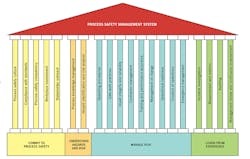Linking safety disciplines, professions and training
This article is part of a series on process safety. Check out the rest of the series here.
Beyond using process safety basics to direct how digitalized tools are applied, they can also determine how traditionally separate engineering fields can coordinate their efforts to improve safety for users and applications.
"Process safety management (PSM) is all about gaining awareness of hazards in operations and addressing them, but it's also about making those gains sustainable over the long term," says David Hurban, engineering specialist at Process Plus, a Plus Groups company, and member of the Control System Integrators Association (CSIA). "Unfortunately, many process industry organizations still don't have direct links between their process safety, process engineering, and process controls and automation disciplines.
"We've found that most process safety personnel are chemical engineers, who are concerned with instantiating events, safety integrity levels (SIL) and layers of protection analyses (LOPA). Process engineers (chemical and mechanical) balance their time between daily operations and continuous improvement. However, many process control and automation engineers are electrical engineers, who are focused on system design such as marshalling and networking components, and more often experts with safety instrumented systems (SIS) architecture. Each group has different narratives, but tighter links between these departments and people are what's needed for sustainable safety."
Derailed by unaligned roles
Hurban reports that process engineers are typically heavily involved in the front-end engineering and design, while process safety and process controls and automation have lesser roles early in the project. Very often this leads to schedule compression for process safety, process controls and automation due to aggressive schedules and business demands. These different schedules and responsibilities eventually converge at the commissioning and startup of the project. At this point in a project, the members of each discipline think differently and have different priorities.
"Electrical people think about discrete point measurements and functionality. Process people think about conditions and logic based on operations. And process safety engineers think about process states and alarm management," explains Hurban. "That's why system integrators like Process Plus try to keep the owner's overall interests in mind, by understanding the relationships of these downstream players. By recognizing each of the roles and their importance, deliverables such as the design basis, process control narratives, and process hazard analyses (PHA) are completed before or during detail design of the project."
To bridge disconnected disciplines and develop an effective process safety program, Hurban adds that owner/operators must start with a questioning attitude, and defy clichés like, "We always did it this way" or "You can't fix stupid," and shift from thinking that safety issues and solutions for other users don't apply to them to instead asking how they could apply to them. "This will help them remove their blinders," says Hurban. "If you have acid in a batch reactor, and you add water, it's going to cause a violent exothermic reaction no matter what site or organization is doing it."
Hurban adds there are many helpful process safety guides, such as the "20 elements of risk-based process safety" (Figure 1) from the classic book, Guidelines for Risk Based Process Safety, by the Center for Chemical Process Safety. Users should also consult local building codes, National Fire Protection Association rules, and the other consensus standards that make up recognized and generally accepted good engineering practices (RAGAGEP) for process safety (Figure 1).
Figure 1: The 20 elements of a risk-based process safety (RBPS) management system are supported by its four foundation blocks. They consist of commitment to process safety, understanding hazards and risks, managing risk and learning from experience, according to the Guidelines for Risk Based Process Safety by the Center for Chemical Process Safety. Source: CCPS and AIChE
"It's important to look at these safety standards and other areas to learn what to do when something isn't covered," adds Hurban. "Process safety isn't something you can set and forget. It has to be responsibility of everyone is an organization, but they should also get the help they need to establish and maintain it."
Necessity drives innovation
Once a safety mindset and commitment are established, Hurban reports an organization and its team can start checking out their processes, controls and other systems, test existing safety functions, and determine what they need to update or add. "If there's an existing alarm on a process, there needs to be a response in place for adjusting to deviations," says Hurban. "If there isn't the capability or time to respond, then that process needs to be redesigned."
Hurban adds many new technologies and software are available for improving or implementing process safety, which often integrate more data, better graphics and augmented reality (AR). "These tools can bring up needed information into 3D renderings, and get the right data into the rights hands," says Hurban. "For instance, something as simple as a pump can have information such as discharge pressure, operating procedures, maintenance records and LOTO diagrams."
In addition to these technology improvements, Hurban explains the key is having robust organizational and process management of change (MOC) procedures, evaluating if there's enough personnel to run existing processes safely, and getting rid of or combining duplicate roles—or creating new ones if needed. "For example, if R&D is running a new product or experimental process plan that may introduce errors and risks, then entrance and exit conditions are needed for their experiments, so errors are avoided," he says. "The main question is, 'Do I have the right process for evaluating changes?' Once you do, then you can rank the answers by how much risk they have, as well as the recommendations for qualifying the reducing that risk."
Seeking training, too
In addition, after idling to varying degrees during the COVID-19, many process industries are trying to ramp up as its wanes. However, some are discovering they don't have enough staff, while others are finding they need to refresh process safety and other skills.
"More and more clients are asking for training programs from our process safety group," says Chet Barton, controls and automation process safety leader, Hargrove Controls+Automation in Baton Rouge, La., which is a certified CSIA member. "Standards like IEC 61511 call for facilities to train operations and maintenance staff in process safety, so there's an understanding of interlocks and how to respond to alarms quickly. An increasing number of refineries and chemical manufacturers are seeking more formal instruction on safety interlocks and protective layers."
Training is needed to increase awareness of the importance of interlocks and alarming, both of which are identified during a hazard operations (HazOp) study. Alarms and interlocks can be part of a safety PLC or a basic process control system (BPCS), and it’s extremely important that operations and maintenance staff understand the importance of both.
"Users may be seeking to reduce a particular hazard when doing a HazOp, so they evaluate the likelihood and severity of possible outcomes with it," says Barton. "ISA has several working groups for its standard on properly applying protection layers. Users must perform a LOPA to determine if they're at an acceptable safety level."







